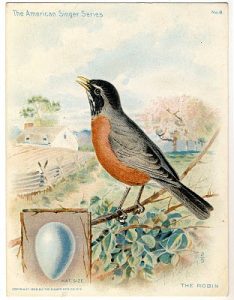 The air will be increasingly filled with bird song this month as more species return from the south.
The air will be increasingly filled with bird song this month as more species return from the south.
Learning to identify birds by the sounds they make takes time and effort, but it can deepen your connection to your garden as you become increasingly aware of what’s going on around you.
The words “singing” and “calling” are often used interchangeably when talking about birds, but they are different things that serve different purposes.
Bird Song
Only the males sing in most songbird species. The common local exceptions are female Northern Cardinals, Baltimore Orioles, and Rose-breasted Grosbeaks, who sometimes sing from/near their nests.
Bird songs tend to be more musical than calls and males use them for two distinct purposes:
To define their territories. If you take the time to watch a singing bird, you’ll find that he sings from a perch for a while, then moves to another perch to sing for a while, and so on. Over time, you’ll find that he uses the same song perches. If you listen, you’ll likely hear another male somewhere else singing in response to the song of the one you’re watching. Males do this to define and defend the boundaries of their territory – an auditory fence, of sorts. Birds will fight for this if they have to, but they rely on song as their primary way of setting up shop for the breeding season.
To attract females. After a male has established his territory, his song not only serves to maintain it, but also to attract a mate for the season. In many songbird species, males arrive from the south about a week before the females, so they can establish their territory in time for the females’ arrival.
Bird Calls
Bird calls are often short and sharp notes or barks used to communicate with other birds of the same or different species, as well as potential predators and humans. Calls are used to maintain contact with mates and family members, to warn each other of potential danger, and to “yell” at potential predators (including birdwatchers).
Learning Bird Songs & Calls
It can take years to learn to identify birds by ear. The best way to start is to get to know the songs of the most common species. This allows you to build a repertoire that makes it easier to grow by comparing new songs to familiar ones.
The song of the American Robin is an excellent example: I describe the song of a Baltimore Oriole as a Robin who’s taken singing lessons, the song of the Rose-breasted Grosbeak as a Robin who’s had 3 or 4 espressos, and the song of a Scarlet Tanager as a Robin with a sore throat.
Learning the songs of many species is made easier with mnemonics – words that emulate the sound of the song. Here are a few to play with this spring:
American Robin: a loud, rich Cheer up, cheerily! Cheerio!
House Sparrow: a loud Chirp! Chirp! that often comes to mind when we think of bird song
Northern Cardinal: a loud Peer-Peer-Peer Pretty Pretty Pretty Pretty!, usually sung from near the top of a tree
American Goldfinch: a happy-sounding, apparently random, musical babble that often contains a phrase sounding like Potato-chip!
House Finch: another happy-sounding, apparently random, musical babble that sounds a bit raspier in places – like a Goldfinch with a sore throat
If you’re interested in learning more about our local bird species, I (Andrew Jobes) moderate a Facebook group called Peterborough Ontario Birds, which currently has 168 members. I’m cultivating an online birding community that can act as a forum for local birders and those interested in learning more about birds to share exciting and interesting observations, ask questions, and learn bird identification tips, ecology, and other interesting facts. I also invite members to post pictures or videos that capture audio for other members to help with identification. I invite you to look the group up, ask me to join it, and have fun learning
~ Andrew

